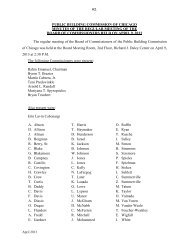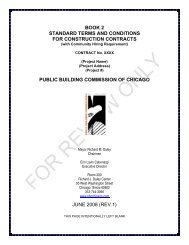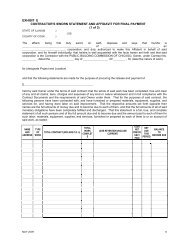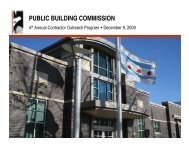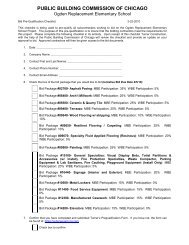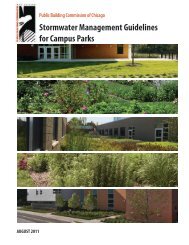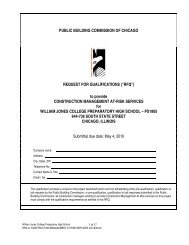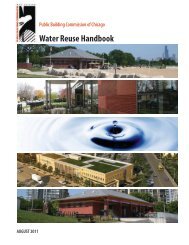Revised Specifications - the Public Building Commission of Chicago
Revised Specifications - the Public Building Commission of Chicago
Revised Specifications - the Public Building Commission of Chicago
Create successful ePaper yourself
Turn your PDF publications into a flip-book with our unique Google optimized e-Paper software.
PBC Control Rev: 1_09/07/09 PD<br />
Project Rev C_07/02/10<br />
3.2 INSTALLATION<br />
A. Install valves as indicated, according to manufacturer's written instructions. Ball valves<br />
are to be installed where shown on drawings/drawing details as required by Test &<br />
Balance Contractor to successfully balance <strong>the</strong> complete system.<br />
B. Piping installation requirements are specified in o<strong>the</strong>r Division 15 Sections. Drawings<br />
indicate <strong>the</strong> general arrangement <strong>of</strong> piping, fittings, and specialties.<br />
C. Install valves with unions or flanges at each piece <strong>of</strong> equipment arranged to allow<br />
servicing, maintenance, and equipment removal without system shutdown.<br />
D. Locate valves for easy access and provide separate support where necessary.<br />
E. Install valves in horizontal piping with stem at or above <strong>the</strong> center <strong>of</strong> <strong>the</strong> pipe.<br />
F. Install valves in a position to allow full stem movement.<br />
G. For chain-wheel operators, extend chains to 72 inches above finished floor elevation.<br />
H. Installation <strong>of</strong> Check Valves: Install for proper direction <strong>of</strong> flow as follows:<br />
1. Swing Check Valves: Horizontal position with hinge pin level.<br />
2. Wafer Check Valves: Horizontal or vertical position, between flanges.<br />
3.3 SOLDERED CONNECTIONS<br />
A. Cut tube square and to exact lengths.<br />
B. Clean end <strong>of</strong> tube to depth <strong>of</strong> valve socket with steel wool, sand cloth, or a steel wire<br />
brush to a bright finish. Clean valve socket.<br />
C. Apply proper soldering flux in an even coat to inside <strong>of</strong> valve socket and outside <strong>of</strong> tube.<br />
D. Open gate and globe valves to fully open position.<br />
E. Remove <strong>the</strong> cap and disc holder <strong>of</strong> swing check valves having composition discs.<br />
F. Insert tube into valve socket, making sure <strong>the</strong> end rests against <strong>the</strong> shoulder inside valve.<br />
Rotate tube or valve slightly to ensure even distribution <strong>of</strong> <strong>the</strong> flux.<br />
G. Apply heat evenly to outside <strong>of</strong> valve around joint until solder melts on contact. Feed<br />
solder until it completely fills <strong>the</strong> joint around tube. Avoid hot spots or overheating<br />
valve. Once <strong>the</strong> solder starts cooling, remove excess amounts around <strong>the</strong> joint with a<br />
cloth or brush.<br />
3.4 THREADED CONNECTIONS<br />
A. Note <strong>the</strong> internal length <strong>of</strong> threads in valve ends and proximity <strong>of</strong> valve internal seat or<br />
wall to determine how far pipe should be threaded into valve.<br />
B. Align threads at point <strong>of</strong> assembly.<br />
CHICAGO POLICE DEPARTMENT<br />
12 TH DISTRICT POLICE STATION 15100 -6 VALVES<br />
PBC-PROJECT# 09070



